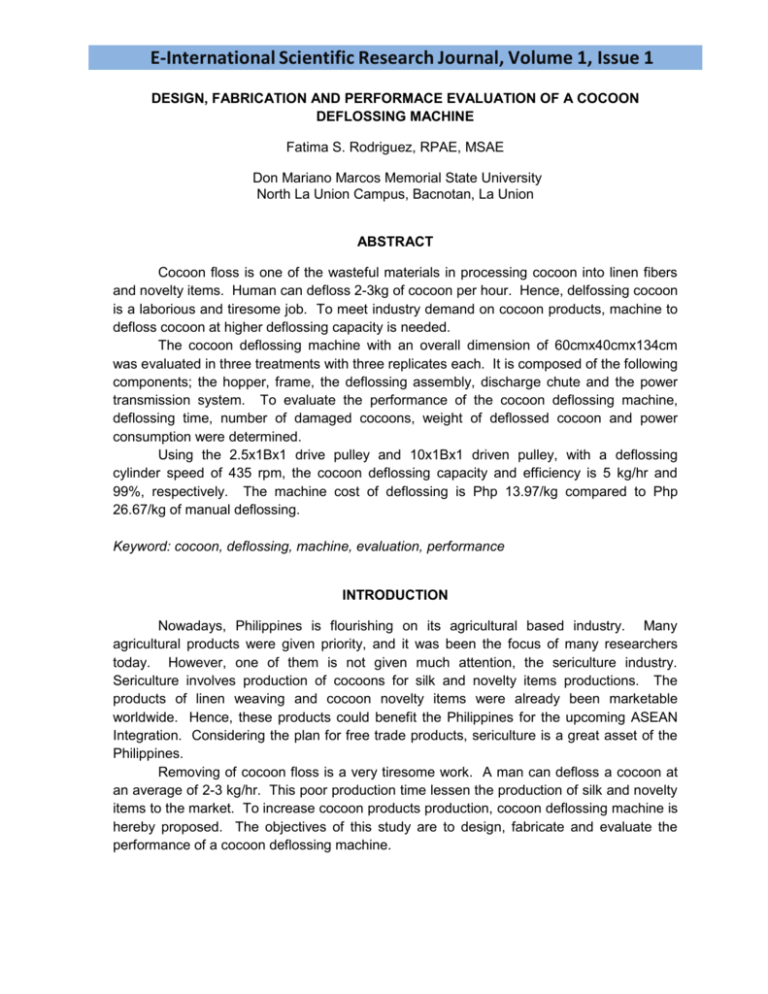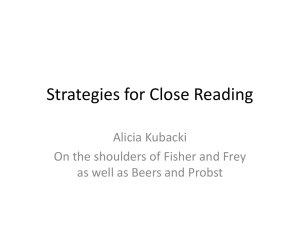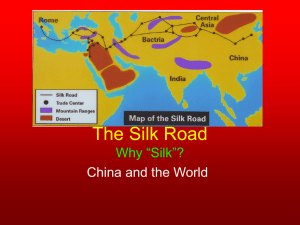the full article here
advertisement

E-International Scientific Research Journal, Volume 1, Issue 1 DESIGN, FABRICATION AND PERFORMACE EVALUATION OF A COCOON DEFLOSSING MACHINE Fatima S. Rodriguez, RPAE, MSAE Don Mariano Marcos Memorial State University North La Union Campus, Bacnotan, La Union ABSTRACT Cocoon floss is one of the wasteful materials in processing cocoon into linen fibers and novelty items. Human can defloss 2-3kg of cocoon per hour. Hence, delfossing cocoon is a laborious and tiresome job. To meet industry demand on cocoon products, machine to defloss cocoon at higher deflossing capacity is needed. The cocoon deflossing machine with an overall dimension of 60cmx40cmx134cm was evaluated in three treatments with three replicates each. It is composed of the following components; the hopper, frame, the deflossing assembly, discharge chute and the power transmission system. To evaluate the performance of the cocoon deflossing machine, deflossing time, number of damaged cocoons, weight of deflossed cocoon and power consumption were determined. Using the 2.5x1Bx1 drive pulley and 10x1Bx1 driven pulley, with a deflossing cylinder speed of 435 rpm, the cocoon deflossing capacity and efficiency is 5 kg/hr and 99%, respectively. The machine cost of deflossing is Php 13.97/kg compared to Php 26.67/kg of manual deflossing. Keyword: cocoon, deflossing, machine, evaluation, performance INTRODUCTION Nowadays, Philippines is flourishing on its agricultural based industry. Many agricultural products were given priority, and it was been the focus of many researchers today. However, one of them is not given much attention, the sericulture industry. Sericulture involves production of cocoons for silk and novelty items productions. The products of linen weaving and cocoon novelty items were already been marketable worldwide. Hence, these products could benefit the Philippines for the upcoming ASEAN Integration. Considering the plan for free trade products, sericulture is a great asset of the Philippines. Removing of cocoon floss is a very tiresome work. A man can defloss a cocoon at an average of 2-3 kg/hr. This poor production time lessen the production of silk and novelty items to the market. To increase cocoon products production, cocoon deflossing machine is hereby proposed. The objectives of this study are to design, fabricate and evaluate the performance of a cocoon deflossing machine. E-International Scientific Research Journal, Volume 1, Issue 1 Objectives of the Study The general objective of this study was to design, fabricate, test, and evaluate the performance of cocoon deflossing machine. Specifically, the study aimed to: 1. design and fabricate a cocoon deflossing machine; 2. test and evaluate the operating characteristics of the machine according to the deflossing time, number of damaged cocoon, weight of deflossed cocoon, and power consumption; and 3. determine deflossing cost. RESULTS AND DISCUSSION Machine Components and Description The cocoon deflossing machine (Figure 2) has three major assemblies: frame and hopper; deflossing cylinder assembly; and power supply and transmission system assembly. The overall dimension of the utility model is 60cmx40cmx134cm. Frame and hopper Assembly Frame. Frame is made up of 2.54cmx2.54cmx0.48cm (1”x1x”3/16”) angle bar. It measures 60cmx40cmx115cm. It supports the hopper and cocoon relay tray. It also serves as motor and deflossing cylinder base. Hopper. It measures 60cmx15cmx20cm and made up of #20 galvanized iron sheet. It is wherein the bag of cocoons will be poured out for deflossing process. Cocoon relay tray. It is made up #20 galvanized iron sheet that measures 52cmx5cmx60cm. It allows the passage of cocoon from the hopper to the inlet tray. It is also aided with a stopper made up of #18 galvanized iron sheet to facilitates the gradual passage of cocoon for the operator to defloss the cocoon efficiently. Deflossing cylinder assembly Inlet tray. This is made up of #20 galvanized iron sheet that measures 24cm at one end and 10cm at the other end. It facilitates relay of cocoon to the deflossing cylinder. It also helps the operator to monitor the undeflossed and deflossed cocoon during operation. Deflosser. It is made up of 10.16 cm (4”) diameter black iron pipe, 30.48 cm (12”) in length and covered with a no.36 sand paper. It removes the cocoon floss while the operator is pressing lightly the cocoon to the cylinder. It rotates counterclockwise to defloss the cocoon efficiently. Drop chute. It is made of #18 galvanized iron sheet with a rectangular slot measuring 23cmx2cm. It facilitate the dropping of deflossed cocoon to the outlet tray. Outlet tray. It is made up of #22 galvanized iron sheet, measuring 24 cm on one end and 5cm on the other end. It facilitates the relay of deflossed cocoon to the collecting bag. E-International Scientific Research Journal, Volume 1, Issue 1 Power supply and transmission system assembly Power supply. 746 watts (1hp) electric motor with 1740 rpm was used to rotate the deflossing cylinder. Fifteen (15) amp push button switch was installed to turn on and off the motor. This is to facilitate deflossing efficiently and effectively. It is supported by 2.54cmx2.54cmx0.48cm (1”x1”x3/16”) angle bars as its base frame. Drive mechanism. The 746 watts electric motor with 2.5x1Bx1 pulley drives the deflosser into counterclockwise rotation by a 10x1Bx1 pulley and transmitted through 56B Vbelt. The electric motor will automatically rotate the deflossing cylinder by pressing the “on” push button. The cocoon will then go into the deflossing cylinder area for deflossing process. After the deflossing process, the operator will press the “off” button switch to allow the delflossed cocoon enter into the drop chute. Another deflossing process can be done by repeating all the steps mentioned. Belt and pulley. A 56B V-belt, 2.5x1Bx1 and 10x1Bx1 drive pulley and driven were used, respectively to transmit the power needed to rotate the deflosser to its counterclockwise rotation. Hopper Stopper Cocoon relay tray Cylinder pulley Drop chute Inlet tray Deflosser Outlet tray motor Frame Figure 2. Cocoon deflossing machine Performance of the Machine The final modified cocoon deflossing machine was tested and evaluated. The results of performance evaluation were as follows: E-International Scientific Research Journal, Volume 1, Issue 1 Deflossing time Table 1. Deflossing time for 20g cocoon, sec TREATMENTS 5”x2.5” 8”x2.5” 10”x2.5” CLOCKWISE 10.2a 15.3b 20.1c MEAN COUNTERCLOCKWISE 07.3a 11.5b 14.4c Means with the same letters are not significantly different at 1% and 5 % level using LSD either in row or column Result shows that the deflossing time is significantly different from each other, for whatever pulley sizes and deflossing cylinder rotation were used. It implies therefore that pulley sizes are significantly different from each other in terms of deflossing time. Number of damaged cocoon Table 2. Damaged cocoon for 20g cocoon, pcs TREATMENTS 5”x2.5” 8”x2.5” 10”x2.5” CLOCKWISE 21.0a 15.0b 07.0c MEAN COUNTERCLOCKWISE 08.0a 05.0b 01.0c Means with the same letters are not significantly different at 1% and 5 % level using LSD either in row or column Table shows that the numbers of damaged cocoon were higher if the deflossing cylinder rotation is clockwise compared to counterclockwise rotation. Moreover, the larger the driven pulley size, the lower the number of damaged cocoon. Furthermore, ANOVA shows significant difference among the treatments. Weight of deflossed cocoon Table 3. Deflossed cocoon for 20g cocoon input, g TREATMENTS 5”x2.5” 8”x2.5” 10”x2.5” CLOCKWISE 05.0a 10.0b 14.0c MEAN COUNTERCLOCKWISE 10.0a 13.0b 19.0c Means with the same letters are not significantly different at 1% and 5 % level using LSD either in row or column Result shows that the deflossed cocoon weight is higher using the larger driven pulley at a deflossing cylinder counterclockwise rotation compared to the smaller driven pulley and deflossing cylinder clockwise rotation. Moreover, ANOVA shows significant difference among the treatments. It implies therefore that the deflossing speed greatly affect the weight of deflossed cocoon. E-International Scientific Research Journal, Volume 1, Issue 1 Power Consumption Table 4. Power consumption for 20g cocoon, W-hr TREATMENTS CLOCKWISE 2.11a 2.96b 4.17c 5”x2.5” 8”x2.5” 10”x2.5” MEAN COUNTERCLOCKWISE 1.51a 2.38b 2.98c Means with the same letters are not significantly different at 1% and 5 % level using LSD either in row or column Table shows significant difference among the treatments. It implies therefore that the driven pulley significantly affect the machine’s power consumption during the operation. Deflossing Cost The deflossing cost of the machine was determined using the deflossing capacity of 5kg/hr, power consumption cost and labor cost of Php 400/day. Table 5 shows that machine’s deflossing cost is Php 13.97/ kg. It is more economical compared to the manual deflossing cost of Php 26.67/kg. Table 5. Deflossing cost, Php/kg Capacity Labor Cost Operation per day Electrical Power Consumption Deflossing cost Deflossing Machine 5kg/hr Php 400/day 6 hours Php 19.20/day Php 13.97/kg Manual Deflossing 2-3kg/hr Php 400/day 6 hours None Php 26.67/kg SUMMARY AND CONCLUSION The main objective of this study is to design fabrication and evaluate the performance of a cocoon deflossing machine. Specifically, to determine the machine’s deflossing capacity, efficiency and deflossing cost. The fabricated deflossing machine was evaluated on its deflossing time, number of damaged cocoon, weight of defloss cocoon and machine’s power consumption. Results showed significant difference among the treatments in any of the evaluated machine’s performance. Moreover, it was revealed that using larger pulley size and deflossing cylinder counterclockwise rotation, the best deflossing efficiency and capacity of the machine will be attained. The deflossing efficiency and capacity was 99% and 5kg/hr, respectively. The machine has an overall dimension of 60cmx40cmx134cm and a cost of Php12, 824.00 with a deflossing cost of Php13.97/kg. E-International Scientific Research Journal, Volume 1, Issue 1 RECOMMENDATIONS Based on the results of the study, the following is hereby recommended: 1. Conduct further study using larger driven pulley and smaller electric motor size. 2. A modification that eliminates human intervention during deflossing process. 3. The machine is recommended for commercialization and extension. LITERATURE CITED Madrid, A. E. 1996. Modification and Performance Evaluationof a Cocoon Deflossing Machine. Don Mariano Marcos Memorial State University-SRDI. Bacnotan.La Union Motorised Cocoon Deflossing Machine. Central Sericultural Research and Training Institute, Mysore, Karnataka Agriculture and Consumer Protection. Silk Reeling and Testing Manual. FAO Corporate Document Repository. ACKNOWLEDGEMENT First of all, the researcher acknowledged and thanked God for His given love, wisdom, and strength for the researcher to finish this study. Also a special thanks to the following: DMMMSU for funding the said research; Dr. Zosima Tadina for her unending support and encouragement for the fulfillment of the study; Prof Rogelio Estacio for catering my paper for publication, and to DMMMSU SRDI, NLUC Research Office, Tatay Rosendo Narciso, Virghel, Ate Badeth, DMMMSU-NLUC Utility Workers, DMMMSU-NLUC Supply Office, and to other DMMMSU personnel who have shared their support.








